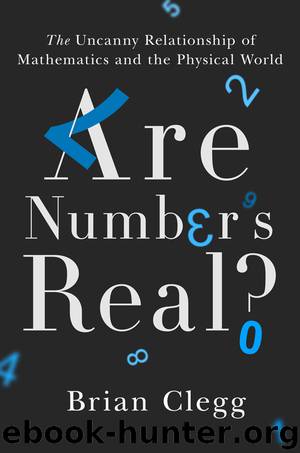Are Numbers Real? by Brian Clegg

Author:Brian Clegg
Language: eng
Format: epub
Publisher: St. Martin’s Press
To a modern physicist these equations are straightforward, bread-and-butter stuff (though most would admire their sophistication). But at the time he produced his original version, Maxwell’s ability to model with mathematics alone was considered daunting by most scientists. William Thomson, Lord Kelvin, a significant contemporary of Maxwell’s who had become a physics professor at an even younger age, was among many who struggled to deal with this degree of abstraction. It didn’t help that no one had seen electromagnetic waves other than light, yet the theory suggested that such waves should be generated simply by sending an electrical charge up and down a piece of metal (an aerial as we now call it). It was a good twenty years before Heinrich Hertz produced the first radio waves this way, helping to make Maxwell’s remarkable achievement a solid success.
Although mathematics had made Maxwell’s work possible, at this stage even he was not prepared to take on all the implications that came out of the formulas. He might have modeled with mathematics, but he wasn’t assuming that the numbers were a direct basis for the nature of reality. In two separate ways, Maxwell was prepared to turn a blind eye to what the numbers said. One was in making an assumption—the other in simply ignoring one of the predictions that came out of the equations, because it seemed too strange.
The assumption was about the ether. Maxwell’s electromagnetic waves depended on empty space being able to sustain electrical and magnetic fields—and it was those fields that supported the waves. There was no need for a medium for the waves to travel through. In fact, as mentioned above, had there been such a medium that behaved like an ordinary physical material, the waves would be odd indeed, because transverse waves that wiggle from side to side can’t travel through the middle of a medium, as the medium would damp down the side-to-side oscillation. Usually such waves travel on an edge—say on the surface of water, or in the side-to-side vibration of a violin string. When waves travel through a medium, like sound through air, they tend to be compression waves, wiggling in the direction of travel.
However, despite his model clearly predicting that there was no need for the ether so that light could travel through empty space from the stars, Maxwell resolutely stuck to his assumption that the ether must exist. All good scientists are a mix of iconoclast and traditionalist. They need to bring fresh new ideas, replacing old ones, but at the same time they can’t start from scratch with everything. They need to build on existing concepts. And all too often, those concepts last long past their sell-by date, as happened with the ether. Interestingly some modern physicists, like the Nobel Prize winner Frank Wilczek, think that in a sense the ether does still exist—as long as we are prepared to consider the existence of the various fields, like the electromagnetic field, that mathematically fill space as a new way of looking at the concept of an ether.
Download
This site does not store any files on its server. We only index and link to content provided by other sites. Please contact the content providers to delete copyright contents if any and email us, we'll remove relevant links or contents immediately.
| Algebra | Calculus |
| Combinatorics | Discrete Mathematics |
| Finite Mathematics | Fractals |
| Functional Analysis | Group Theory |
| Logic | Number Theory |
| Set Theory |
Modelling of Convective Heat and Mass Transfer in Rotating Flows by Igor V. Shevchuk(6348)
Weapons of Math Destruction by Cathy O'Neil(6074)
Factfulness: Ten Reasons We're Wrong About the World – and Why Things Are Better Than You Think by Hans Rosling(4617)
Descartes' Error by Antonio Damasio(3183)
A Mind For Numbers: How to Excel at Math and Science (Even If You Flunked Algebra) by Barbara Oakley(3176)
Factfulness_Ten Reasons We're Wrong About the World_and Why Things Are Better Than You Think by Hans Rosling(3156)
TCP IP by Todd Lammle(3093)
Applied Predictive Modeling by Max Kuhn & Kjell Johnson(2973)
Fooled by Randomness: The Hidden Role of Chance in Life and in the Markets by Nassim Nicholas Taleb(2962)
The Tyranny of Metrics by Jerry Z. Muller(2950)
The Book of Numbers by Peter Bentley(2870)
The Great Unknown by Marcus du Sautoy(2608)
Once Upon an Algorithm by Martin Erwig(2536)
Easy Algebra Step-by-Step by Sandra Luna McCune(2533)
Lady Luck by Kristen Ashley(2493)
Practical Guide To Principal Component Methods in R (Multivariate Analysis Book 2) by Alboukadel Kassambara(2444)
Police Exams Prep 2018-2019 by Kaplan Test Prep(2438)
All Things Reconsidered by Bill Thompson III(2323)
Linear Time-Invariant Systems, Behaviors and Modules by Ulrich Oberst & Martin Scheicher & Ingrid Scheicher(2301)
